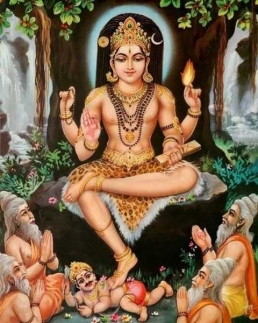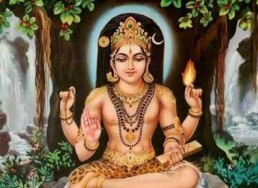Mauna Vyakhya
वर्शिष्ठान्तेवसदृषिगणैरावृतं ब्रह्मनिष्ठैः |
आचार्येन्द्रं करकलित चिन्मुद्रमानन्दमूर्तिं
स्वात्मरामं मुदितवदनं दक्षिणामूर्तिमीडे ‖
varśiṣṭhānte vasad ṛṣigaṇair āvṛtaṃ brahmaniṣṭhaiḥ |
ācāryendraṃ karakalita cinmudram ānandamūrtiṃ
svātmarāmaṃ muditavadanaṃ dakṣiṇāmūrtimīḍe ‖

Description
Meaning of Dakshinamurti
Amürtih is the one who is formless and who is the truth of everything. With maya-sakti Isvara is daksinah, the one who has the capacity to be the creator and sustainer, and also the one who can take back the whole creation into himself. Therefore, Isvara who is daksina as well as amürti is Dakshinamürti.
Daksina also means the southern direction. He is the Lord who is facing the south, daksinn-dik-abhi-mukha murtih. What is the significance of the southern direction? The north attracts, and it stands for moksha. The south stands for samsara; it is Lord Yama’s place. The Lord is everywhere, but the one who wants release from samsara faces the Lord in the north. The Lord has to face you to teach. As the source of all-knowledge, he faces the south. Salutations unto Lord Dakshinamürti who is the source of all-knowledge and the source of all blessing.
Meaning of this Sloka
Mudita-vadanam means the one who has a smiling face. The teacher cannot look very serious when he is teaching that you are ananda. He is sitting there under this tree with a smile.
Svātmārāmam, the one who is reveling in himself, who is anandarūpam, in the form of ananda. Ananda is not necessarily laughing; there can be quiet, smiling ananda too.
Karakalita-cinmudram, whose hand is held in the gesture of wisdom, cinmudra.
Varṣiṣṭhāntevasad-ṛṣigaṇairāvṛtam, surrounded by a group of elderly sages, (Sanaka, and others), who are brahmaniṣṭhas, committed to the knowledge of Brahman.
Acaryendram, the initiator of all the teaching is the Lord, Indra, of the teachers. They say Śrī Dakshiṇāmūrti taught in silence. If you are the sanakadi-jīvas, then, perhaps, silence is enough. If silence were the teaching, then these upanişads will have empty pages instead of text. The teaching is in the form of words.
Mauna-vyākhyā- prakaṭita means what is taught is the intended meaning of the words, sabda-lakṣya, and not the immediate meaning, śabda-vacya. The teaching negates wrong notions you have about yourself. When the negation is complete, you remain as the very lakṣya, the target, the meaning that the words want to convey. The teaching is such that you recognise yourself, dropping all your wrong notions. That is what they call mauna, silence.
Yuvānam, here, means timeless, nitya-yuvā, the one who is not subject to time. He is always young. He faces the south and the students face the north. This is one meaning of Dakṣiṇāmūrti. Another is the one who has all the capacity, dakṣinaḥ, and is formless, amūrtiḥ, dakṣiṇaścāsau amurtiḥ. He is dakṣiṇaḥ, the one who has capacity to be both the maker and the material cause. He is the creator, the sustainer and the one who takes everything back into himself. The idea here is that the Lord is both the manifest and unmanifest jagat, dakṣiṇaḥ. But in truth he is without form, svayam amūrtiḥ. Therefore, the jagat is the Lord whose essential form is free from jagat. That is what he teaches.
Excerpt from the book “Prayer Guide” by Swami Dayananda
Other Dakshinamurthy Shlokams
Dakshinamurthy Stotram
Shlokams,Sankara,Shiva,Dakshinamurthy
The Dakshinamurti Stotra is a Sanskrit religious hymn to Shiva by Sri Adi Shankaracharya. It explains the metaphysics of the universe in the frame of the tradition of Advaita V
Ishvaro Guru Atmeti
Shlokams,Shiva,Dakshinamurthy,Guru,Sankara
Salutations to Lord Dakshinamurti, who is all-pervasive like space but who appears (as though) divided as Lord, Guru, and the Self.
Nidhaye Sarvavidyanam
Shlokams,Sankara,Shiva,Dakshinamurthy
Salutations to Sri Dakshinamurti, the reservoir of knowledge (the abode of all learning), the healer of all those who suffer from the disease of samsāra, and the teacher of the whole world.
Om Namah Pranavarthaya
Shlokams,Sankara,Shiva,Dakshinamurthy
Om. Salutation to the one who is the meaning of praņava, who is in the form of pure knowledge, who is taintless and who is free from any change. To that Sri Dakshinamurti, (my) salutations.
Om Namo Bhagavate Dakshinamurthaye
Shlokams,Sankara,Shiva,Dakshinamurthy
Om. Salutations to Bhagavan Dakshinamurti. (Oh Lord) Bless me with memory, the capacity to think properly, and clarity, wisdom.
Mauna Vyakhya – Dakshinamurthy – In Sanskrit, English Translation, Meaning, Significance and Audio. With commentary by Swami Dayananda

